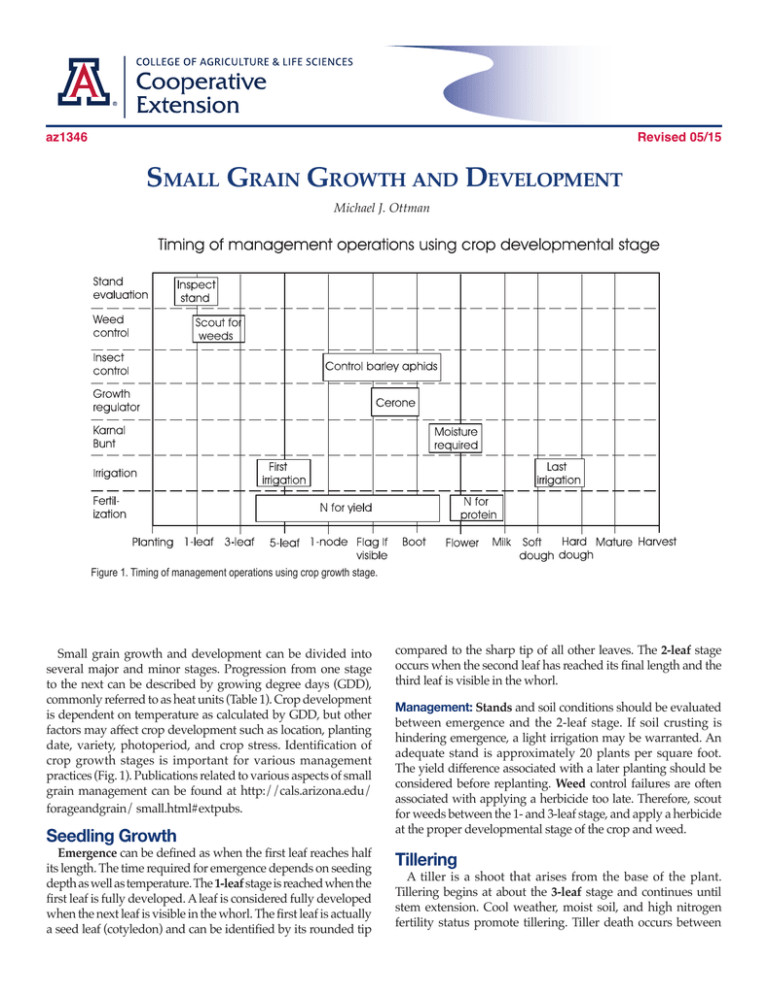S G d
advertisement

az1346 Revised 05/15 Small Grain Growth and Development Michael J. Ottman Figure 1. Timing of management operations using crop growth stage. Small grain growth and development can be divided into several major and minor stages. Progression from one stage to the next can be described by growing degree days (GDD), commonly referred to as heat units (Table 1). Crop development is dependent on temperature as calculated by GDD, but other factors may affect crop development such as location, planting date, variety, photoperiod, and crop stress. Identification of crop growth stages is important for various management practices (Fig. 1). Publications related to various aspects of small grain management can be found at http://cals.arizona.edu/ forageandgrain/ small.html#extpubs. Seedling Growth Emergence can be defined as when the first leaf reaches half its length. The time required for emergence depends on seeding depth as well as temperature. The 1-leaf stage is reached when the first leaf is fully developed. A leaf is considered fully developed when the next leaf is visible in the whorl. The first leaf is actually a seed leaf (cotyledon) and can be identified by its rounded tip compared to the sharp tip of all other leaves. The 2-leaf stage occurs when the second leaf has reached its final length and the third leaf is visible in the whorl. Management: Stands and soil conditions should be evaluated between emergence and the 2-leaf stage. If soil crusting is hindering emergence, a light irrigation may be warranted. An adequate stand is approximately 20 plants per square foot. The yield difference associated with a later planting should be considered before replanting. Weed control failures are often associated with applying a herbicide too late. Therefore, scout for weeds between the 1- and 3-leaf stage, and apply a herbicide at the proper developmental stage of the crop and weed. Tillering A tiller is a shoot that arises from the base of the plant. Tillering begins at about the 3-leaf stage and continues until stem extension. Cool weather, moist soil, and high nitrogen fertility status promote tillering. Tiller death occurs between Table 1. Growing degree days (86/45 °F) required for small grains to reach various growth stages at Maricopa, AZ . Growth stage Description Emergence 1 leaf 2 leaf 3 leaf 4 leaf 5 leaf 6 leaf 1 node 2 node Flag leaf visible Flag leaf collar Boot Heading Flowering Water Milk Soft dough Hard dough Maturity Harvest 1/2 leaf expanded 1 leaf expanded 2 leaves expanded 3 leaves expanded 4 leaves expanded 5 leaves expanded 6 leaves expanded 1 node above ground 2 nodes above ground Flag leaf visible Flag leaf collar visible Swelling of flag leaf sheath Head emerges Pollen shed Kernel watery Kernel milky Kernel mealy Kernel hardening, losing color Kernel mature, heads tan Kernel dry, brittle, hard Growing degree days (86/45) ºF* Barley Barley (Short(FullDurum Wheat Season) Season) 93 95 100 98 127 130 137 134 196 201 212 206 264 271 286 279 333 342 360 351 401 412 434 424 470 483 509 496 528 602 564 522 631 707 675 631 653 780 813 768 708 836 873 826 763 893 933 885 799 930 971 923 821 952 1142 1051 952 1117 1306 1197 1083 1282 1470 1342 1280 1529 1716 1559 1358 1628 1814 1646 1476 1777 1962 1777 1820 2121 2306 2121 * The growth stages in this table represent the main stem, except at maturity and harvest where all stems are represented. Growing degree days were obtained from the Arizona Meteorological Network, AZMET (http://cals.arizona.edu/azmet). Growing degree days (GDD) are based on Barcott and Mucho for short season barley; Baretta, Commander, Max, and Nebula for full season barley; the average of current commercial varieties for durum; and Yecora Rojo for wheat. The GDD to required to reach various growth stages may vary according to the year, location, and variety. For a listing of the current varieties and their relative heading and maturity dates see http://cals.arizona.edu/pubs/crops/az1265.pdf) . stem extension and flowering, and as many as half of the tillers produced may either die or not produce a grain head. The grain head is initiated at the 4- leaf stage, but can only be seen clearly using a microscope. At the 5-leaf stage, a pseudo-stem formed by the leaf sheaths becomes apparent. The stem begins to elongate after the 6-leaf stage in most varieties. Management: The first irrigation is usually needed by the 5-leaf stage, although it may be applied early in cracking soils or to encourage tillering. Nitrogen fertilizer may be applied at this time to encourage tillering, and is usually applied in every irrigation until flowering, or slightly thereafter. Stem Extension Stem extension, or jointing, begins when the first node is visible above the soil surface. Leaves continue to develop during this stage, although they may be difficult to count accurately due to death of the lower leaves. Most durum varieties in Arizona develop about 8-10 leaves, while barley develops 8-12 leaves. Stem extension is the time of most rapid growth and nutrient uptake. The 1-node stage begins after the development of 6 leaves, or 7 leaves in the case of full season barley. Nodes can be identified by cutting the stem in half, stripping the leaf sheath away from the stem, or by running your thumb and forefinger along the stem. The growing point is often mistaken for a node, 2 The University of Arizona Cooperative Extension but is identified easily when the stem is cut open. At the 2-node stage, 2 nodes are visible above ground, and plant height is increasing rapidly. On most varieties except for full-season barley, the flag leaf is visible when 3 nodes are visible above ground. This stage is difficult to identify unless the leaf sheaths are removed exposing the emerging head. When the flag leaf is fully developed, the flag leaf collar becomes visible and the portion of the stem below the flag leaf elongates elevating the flag leaf above the previous leaf. Booting occurs when the stem swells due to the passage of the emerging head, and begins near the end of flag leaf elongation and ends when awns become visible at the flag leaf collar. Heading begins when the tip of the head is visible at the flag leaf collar and ends when the base of the head clears the flag leaf collar. The stem continues to grow and raise the head above the flag leaf collar. Head extension is usually complete by flowering, except for barley which may flower near head emergence. Management: The crop is most sensitive to water and nitrogen stress during this stage, so timely irrigations and application of nitrogen fertilizer are more critcal during this time period than any other. The only insect that normally is a problem on small grains in Arizona is aphids on barley. These insects usually do not appear until stem extension, and if they appear after heading, chemical control is not necessary. Natural enemies are often effective in reducing aphid populations. Cerone is a plant growth regulator used to control height and reduce lodging in small grains. This chemical should be applied between the flag leaf visible stage and boot to be most effective. Wet conditions between awn emergence and the end of flowering are critical for the development of Karnal bunt, but chemical control measures are not currently recommended Grain Development Flowering is identified when the anthers are yellow and shedding pollen. The anthers are usually externally visible during flowering, but may not extrude under water stress. The kernel watery stage begins after pollination. During this stage, the kernel will develop in size and will have a water consistency. Once the kernel obtains its final length and width, it will accumulate dry weight more rapidly and the kernel contents will have a milky consistency. As more dry weight is deposited and the kernel loses moisture content, the kernel will have a mealy consistency referred to as soft dough. At the hard dough stage, it is difficult to squeeze contents out of the kernel and the kernel loses its green color. Dry weight accumulation ceases at physiological maturity indicating grain yield has been made. This stage occurs when the heads have completely turned color from green to tan and grain moisture content at this time is about 38%. Small grains in Arizona are ready for harvest when the grain moisture content is less than 10%. The amount of time required between physiological maturity and harvest is usually a minimum of 1012 days, but this period can be extended if drying conditions are not favorable or the soil is moist. Management: Nitrogen fertilizer applied before heading affects yield primarily, and that applied between heading and about 2 weeks after flowering is most effective in increasing grain protein content. The soonest the last irrigation should be applied on most soils is the soft dough stage, and any irrigation applied after physiological maturity will have no effect on grain yield. COLLEGE OF AGRICULTURE & LIFE SCIENCES Cooperative Extension The University of Arizona College of Agriculture and Life Sciences Tucson, Arizona 85721 Michael J. Ottman Agronomy Specialist Contact: Michael J. Ottman mottman@cals.arizona.edu This information has been reviewed by University faculty. extension.arizona.edu/pubs/az1347-2015.pdf Originally published: 2004 Other titles from Arizona Cooperative Extension can be found at: extension.arizona.edu/pubs Any products, services or organizations that are mentioned, shown or indirectly implied in this publication do not imply endorsement by The University of Arizona. Issued in furtherance of Cooperative Extension work, acts of May 8 and June 30, 1914, in cooperation with the U.S. Department of Agriculture, Jeffrey C. Silvertooth, Associate Dean & Director, Extension & Economic Development, College of Agriculture Life Sciences, The University of Arizona. The University of Arizona is an equal opportunity, affirmative action institution. The University does not discriminate on the basis of race, color, religion, sex, national origin, age, disability, veteran status, or sexual orientation in its programs and activities. The University of Arizona Cooperative Extension 3





